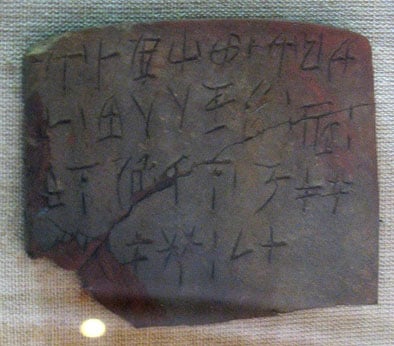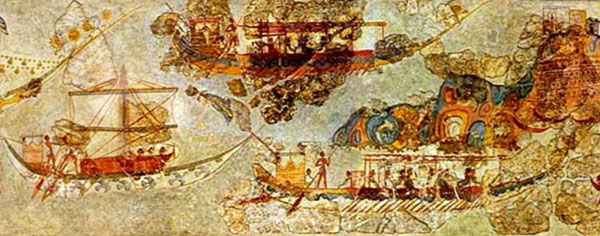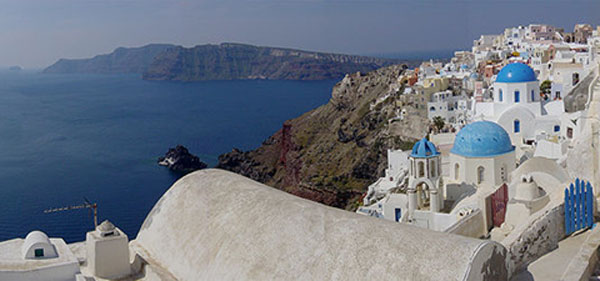The ancient settlement of Akrotiri and the mass exodus of Therans
Akrotiri is a Minoan Bronze Age settlement situated on the Greek island of Santorini (classically and more recently referred to as Thera), in the southern Aegean Sea. Buried underneath ash and pumice, the site was discovered by Greek archaeologist Spyridon Marinatos in 1967 CE. Santorini is the largest island of the circular archipelago, the Cyclades. The greater parts of the island circle an active volcano.
Settled by a thriving Minoan population, Akrotiri met its end in the late 17th century BC during the Theran volcanic eruption. We do not know what the name of the island and its people were in antiquity. The Bronze Age started in the Aegean as early as the late 4th millennium BC, but the origins of its people are not known with certainty. The historians Thucydides (c. 460 - 395 BC) and Herodotus (c. 484 - 425 BC) claim that the earliest inhabitants of the Cyclades were Carians who immigrated from the south-western parts of Anatolia (i.e. Asia Minor). Herodotus added to this claim by stating that these inhabitants were completely independent from the Minoans of the nearby island of Crete and supplied sailors for ships of the legendary King Minos.
The Minoan civilization arose during the Bronze Age on the island of Crete and flourished throughout the entire Mediterranean, expanding into the rest of the Aegean (including Santorini), the Greek mainland, and settling in coastal ports found in Anatolia, the Levant, and Egypt. They excelled in seafaring and were well renowned for their manufactured and perishable goods (Castleden, 116 and Fitton 95-100). Their modern name, Minoan, was coined by Sir Arthur Evans, an English archaeologist, who discovered the civilization on Crete in the beginning of the 20th century AD. They were named after the very same mythical King Minos mentioned earlier (Castleden, 1). We do not know what the Minoans of Crete called themselves but modern archaeology and translations of ancient texts have revealed that the Egyptians referred to these peoples as coming from the place of "Keftiu" and the Semites of the Near East referred to the same island as "Caphtor" and "Kaptara" (Castleden, 21).
Altogether the Minoans were a highly skilled and advanced peoples. They had their own still undeciphered language and system of writing referred to today as Linear A (Castleden, 102). The many attempts to decipher their language have led many to surmise it is from an Indo-European subset; but this is still mainly just speculation. From what we can understand, they had a complex religion, a great love for nature and art, and also an advanced understanding of architecture, building earthquake-proof multi-storied homes with plumbing to redirect fresh water and waste. Yes, they had indoor toilets (Fitton, 125)!

Linear A writing. Photo source: Wikipedia
The year was approximately 1628 BCE. The Theran volcano erupted and buried the nearby city of Akrotiri in volcanic ash, thus preserving the remains of its beautiful frescoes, objects, and buildings (Fitton, 33). Unlike the Atlantean legends of later and more modern misconceptions, it is recently clear to historians that the eruption was not as instantaneous as many originally believed but rather a slow and gradual process; a sort of crescendo to an eventual climax, possibly leaving enough time for the island's inhabitants to organize themselves and seek refuge elsewhere. Unlike the devastation that befell Pompeii (late 1st century CE), this could explain why to date no bodies have been found in the excavations of Akrotiri. The archaeological evidence does indicate that the island's inhabitants dropped their entire lives and fled, but to where? It should be noted that excavations at the site are largely incomplete and continue to this day, leaving us with the possibility of one day discovering these bodies, at least of those who were left behind.

A segment of a large fresco of a ship procession from Bronze Age excavation at Akrotiri. Photo source: Wikipedia

Excavation at Akrotiri, Thera. Photo source: Wikipedia
It does make one wonder, were their survivors? While not impossible, it is difficult to believe that a mass exodus of ancient Therans escaped the archaeological record. If they resettled elsewhere, would it have been on Crete or any other island to the north of the Aegean? The difficulty in identifying such a resettlement is that these migrants would have assimilated fairly well in an existing Minoan culture.
I am reminded of the Odyssey. At one point of the epic tale, Odysseus washed ashore on Scheria, the land of the Phaeacians. Just prior to being discovered and led to the palace of King Alcinous, Homer informs us of Nausithous, the father of Alcinous, and how he led a migration of Phaeacians from Hypereia to Scheria in order to escape the Cyclopes. The exact coordinates of these two location still elude modern scholars and have led many to conclude that they are nothing more than a mythical creation by the poet. According to the Odyssey, Hypereia was located near the Cyclopes. Hypereia translates to "high-land." This description could be synonymous with the mountainous terrain of the island of Santorini, parts of which rise to very high altitudes right out of the sea. What of the Cyclopes? From the hymns of Callimachus to the plays of Euripides, historical records as early as the late 4th century BCE have linked the Cyclopes with volcanoes. The name Cyclops (singular form) translates to "round-eyed" or "circle-eyed." Could this be a representation of the opening of a volcano and could the story of the Phaeacians and their leaving Hypereia be an allegorical interpretation of the Theran eruption somehow preserved in the traditions of later Greeks? With continued archaeological discoveries being made almost daily, these answers will eventually be revealed.
Featured image: The island of Santorini. Photo source: Wikipedia
Sources
Castleden, Rodney. Minoans: Life in Bronze Age Crete. London: Routledge, 2002. [Print]
Fitton, J. Lesley: Minoans. London: The British Museum Press, 2002. [Print]
Thucydides. History of the Peloponnesian War, I, 4.
Herodotus. The Histories, I, 171.
Homer. The Odyssey, VI, 4–8.
Perseus Digital Library, 2014. [Online]
Available at: www.perseus.tufts.edu/hopper
[Accessed 27 April 2014].
Wikipedia, 2014. Spyridon Marinatos. [Online]
Available at: www.en.wikipedia.org/wiki/Spyridon_Marinatos
[Accessed 27 April 2014].


















Comments
I can recall at least one earlier past lifetime on Minoan Crete, several millennia ago. This was before the great Thieran volcanic disaster. We lived at a time when Minoan Crete was in and era of peace and prosperity. All the details I can recall as re. physical appearance of the people, daily life activity, scenery, buildings etc. were the Minoan world. The people I were related to all spoke the Minoan language. Many of the people I knew in that earlier lifetime, are people I've know today reincarnated in the modern world. What I'm trying to get at is that earlier past lifetime memories could be very useful in the retrieval of unknown historical information; retrieving the unknown Minoan language, data on early civilizations, their religions, history, science and technologies would be possible.